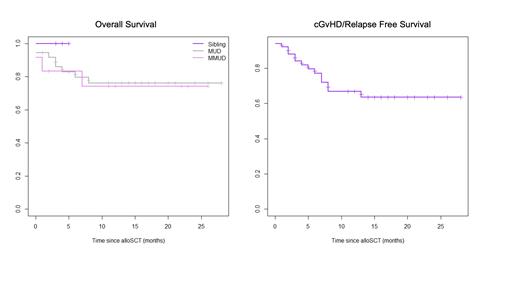The Post-Transplant Cyclophosphamide (PTCY) approach was first studied in the haploidentical transplant setting, and it resulted in high percentages of engraftment and reduced frequency of acute and mainly chronic GvHD as well as non-relapsed mortality. PTCY is now increasingly being used in HLA-partially and fully matched unrelated, as well as matched related donors. The aim of this study was to investigate the impact of PTCY on the incidence of chronic GvHD, disease relapse and infections because of possible cellular immune impairment.
Fifty-one consecutive patients who underwent allogeneic hematopoietic stem cell transplant from an unrelated donor were studied. PTCΥ was administered on days +3 and +4 post-transplant at a dose of 50 mg/kg/day. Additional GvHD prophylaxis included tacrolimus and mycophenolate mofetil starting on day +5. In patients with no evidence of GvHD, immunosuppression was gradually tapered, and eventually stopped by day +90. We evaluated the safety and efficacy of PTCY, focusing on toxicity, engraftment, aGvHD and cGvHD frequency, relapse, non-relapse mortality, survival and immune reconstitution.
We performed 51 unrelated donor transplants with PTCY from January 2021 to May 2023 in patients with a median age of 52 (18-69) years. The indication for transplant was AML/MDS (n=36), NHL/CLL, (n=2), pMF (n=2), CML (n=2) και ALL (n=9). Disease risk index (DRI) was intermediate for most patients (34/51), 7 had low and 10 had high DRI. Thirty-seven patients received myeloablative conditioning and 14 reduced-intensity. Overall, three patients were transplanted from a matched sibling, 36 from an 8/8 matched unrelated donor and 12 from an 7/8 HLA-matched unrelated donor. All patients received a peripheral blood graft with a median CD34+ cell dose of 6.97×10e6/kg (3.27-15.82). The most common toxicities observed were mucositis (n=34), diarrhea (n=40), vomit (n=12), liver toxicity (n=3) and acute kidney injury (n=4) - which in all cases were grade Ι-ΙΙ. Engraftment, defined as neutrophils >500/μl, was achieved in 46 cases in a median of 16 (13-27) days. Three patients died before day +28 due to NRM and two additional patients with myelofibrosis and MDS respectively had primary graft failure.
The cumulative incidence of aGvHD, grade ΙΙ-IV at 100 days was 46.7% (95%CI: 34.1-63.8). However, aGvHD, grade ΙΙΙ-IV was only 3.9% (95%CI: 1.0-15.5). The cumulative incidence of cGvHD at 18 months was 13,4% (95%CI: 5.8-31.0), with only one case of extensive cGvHD. In a median follow-up of 14.5 (1-28) months, disease free (DFS) was 76,8% (95%CI: 65.5-90.0) at 18 months and overall survival (OS) was 76.3% (95%CI: 64.9-89.8) and 71.6% (95%CI: 58.6-88.3) respectively. There was no statistically significant difference in survival rates for patients who received an HLA mismatched and those who received an HLA-matched unrelated-donor transplant. cGvHD-Relapse-Free Survival was 63.5% (95%CI: 50.3-80.1). Two patients died of their disease and non-relapse mortality was 19.1%. Specifically, 6 patients died of Infections, 1 due to primary graft failure, 1 due to heart failure, and 1 due to Idiopathic Pulmonary Syndrome. Immune reconstitution at month 6 was 420 cells/ul (20-2225) and 179 (13-594) for CD8 and CD4 respectively. At month 12 CD8 and CD4 were 552 (55-3002) and 364 (60-787). 31 viral infections were documented in 28 patients (Respiratory viruses n=13, BKV n=11, CMV n=7). In regard with opportunistic infections, 2 patients had fungal infections and 1 patient atypical mycobacterium.
We used PTCY for GvHD prophylaxis in mismatched, full-matched unrelated and matched sibling donor transplants with peripheral blood stem cell graft. This approach was well tolerated. Engraftment was documented in most patients, with a low incidence of grade III-IV aGvHD. Importantly cGvHD, which is the most important barrier in unrelated donor transplant, was substantially low with this method. Cellular immune reconstitution was adequate for CD8 but somewhat impaired for CD4. However, the incidence of viral and opportunistic infections was not increased. Overall, there are implications that PTCY may revert the negative impact of HLA mismatch on the outcomes of unrelated donor transplantation, while it is also a viable option for MUD and MSD transplant.
Disclosures
No relevant conflicts of interest to declare.


This feature is available to Subscribers Only
Sign In or Create an Account Close Modal